Chevrolet
Malibu Spark Plugs Replacement Guide
How to change the spark plugs in a 9th
generation Chevy Malibu with the Ecotec LFV 1.5L turbo I4 engine.
By Paul B. Michaels Author & Photographer Auto Mechanic Since 1989 |
||
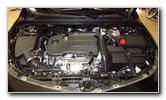 2020 Malibu 1.5L I4 |
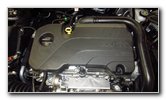 Ecotec LFV Turbocharged |
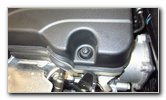 Front Right - Torx Bolt |
| This automotive
maintenance tutorial was specifically written to assist owners of the ninth
generation 2016, 2017, 2018, 2019, 2020, 2021, 2022 and 2023 GM Chevrolet
Malibu with the Ecotec LFV 1.5L turbocharged I4 engine in checking or
changing the spark plugs. (The procedure should be the same or very similar for the 2.0L and 1.8L engines.) The 9th generation Malibu was supposed to undergo a "facelift" in 2022 or 2023 and the refreshed vehicle may have continued being produced into the 2024 and 2025 model years but it will now apparently be discontinued after the 2023 model year. Owners of other General Motors vehicles from Chevrolet, Buick, Cadillac, GMC and Holden such as the Impala, Corvette, Bolt, Sonic, Spark, Express, Trax, TrailBlazer, Equinox, Traverse, Blazer, Tahoe, Suburban, Colorado, Silverado, Cruze, Volt, Camaro, Encore, Envision, Enclave, Regal, LaCrosse, Canyon, Sierra, Terrain, Acadia, Yukon, Savana, XT4, XT5, XT6, Escalade, CT4, CT5, CT6 and Commodore may also find these DIY instructions to be helpful. The OEM (original equipment manufacturer) iridium spark plugs in this 2020 Malibu were the ACDelco 41-157 (also known as GM part number 12686362). If you have trouble finding the OEM ACDelco 41-157 spark plugs you can instead use the ACDelco 41-156 (also known as GM part number 12683541). The tools and other items needed to complete this procedure include a Torx T30 star bit screwdriver, a 10mm socket with a 1/4" drive ratchet, a 14mm spark plug socket, a long extension bar, a 3/8" drive ratchet and a tube of dielectric grease. The first two steps are to open the hood and then locate the black metal Torx bolt on the front right (driver side) corner of the plastic engine cover. |
||
|
|
||
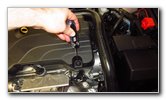 Loosen Counterclockwise |
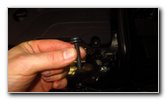 Torx Bolt Removed |
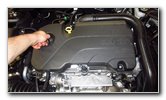 Twist Off Oil Fill Cap |
| Loosen the single
black metal bolt on the front right corner of the plastic engine cover by
turning it in the counterclockwise direction with a Torx T-30 star bit
screwdriver. Set the bolt aside in a safe place. Twist off the oil fill cap by turning it in the counterclockwise direction. |
||
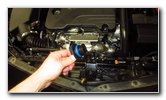 Oil Filler Cap Removed |
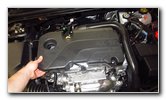 Pull Off Plastic Cover |
 Engine Cover Removed |
| Set the oil filler
cap aside in a safe place. Carefully pull the plastic cover off the top of the engine and set it aside in a safe place. |
||
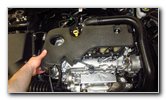 Foam Rubber Cover |
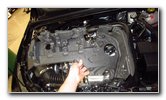 Remove Rubber Cover |
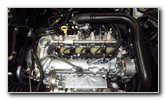 Ignition Coils Exposed |
| Lift off the foam
rubber noise insulation cover off the top of the engine and set it aside
with the plastic cover. Push a small clean towel into the oil fill port to help prevent from having debris fall down into the engine. Once the two covers are out of the way, you'll be able to see the four ignition coil housings on top of the valve cover. If you have access to compressed air or a wet/dry shop vacuum, thoroughly clean off the top of the engine to help prevent from having debris fall down into the spark plug well or the cylinder. |
||
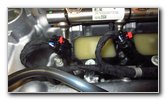 Black Electrical Connector |
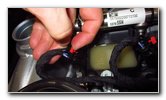 Slide Out Red Lock Tab |
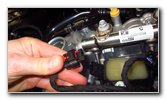 Push In Release Tab |
| Slide out the small
red plastic lock tab on the electrical connector away from the ignition coil
housing. Then push down on the black plastic release button before sliding the electrical connector straight off the left side of the ignition coil. |
||
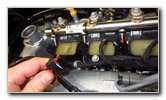 Power Plug Removed |
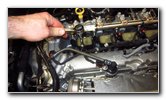 Loosen Counterclockwise |
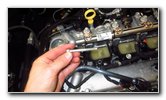 Ignition Coil Bolt Removed |
| Since the spark
plug wells are positioned at an angle (tilted / slanted), you'll need to
also disconnect the power plug for the second ignition coil in order to
check or change the first plug. I recommend only checking or changing one spark plug at a time to help further reduce the risk of having debris or a foreign object fall down into the cylinder. Loosen the silver metal bolt that secures the ignition coil housing to the valve cover by turning it in the counterclockwise direction with a 10mm socket and a 1/4" drive ratchet. Set the ignition coil bolt aside in a safe place. |
||
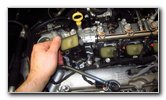 Pull Out Ignition Coil |
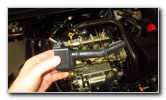 Ignition Coil Removed |
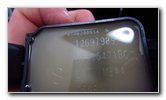 ACDelco 12697989 |
| Gently rotate the
ignition coil back and forth a few times to make sure the rubber boot at the
bottom isn't stuck or "frozen" to the top of the old spark plug.
Carefully pull the ignition coil straight out of the spark plug well and set it aside in a safe place. If you have a SES or CEL (service engine soon / check engine light) on the gauge cluster use an OBDII scanner (also known as an OBD2 scan tool) to check for an ignition coil related DTC (diagnostic trouble code) such as P0351, P0352, P0353 or P0354. If you need to replace a failing or faulty ignition coil, the General Motors OEM (original equipment manufacturer) part number is ACDelco 12697989 also known as part number ACDelco 12635672. |
||
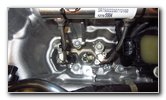 Old Spark Plug In Well |
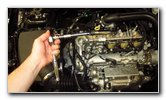 Attach Spark Plug Socket |
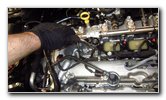 Loosen Counterclockwise |
| Attach the 14mm
spark plug socket to the 6" or 9" extension bar and a 3/8" drive ratchet. I like to use some electrical tape to secure the socket to the extension bar to help prevent it from popping off and becoming stuck down at the bottom of the spark plug well. If you don't have a 14mm spark plug socket, a 9/16" spark plug socket will work. Lower the socket down into the well and push it over the top of the old spark plug. Carefully loosen the old spark plug by turning it in the counterclockwise direction. If you have trouble loosening the old spark plug due to corrosion (rust) or debris, spray a very small amount of penetrating oil down into the well and allow it to penetrate the threads for at least 10 to 15 minutes. |
||
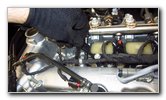 Spin Out By Hand |
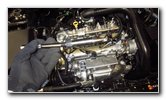 Lift Out Old Spark Plug |
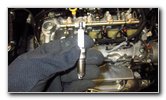 Inspect Old Spark Plug |
| Once the old spark
plug is loose, detach the 3/8" drive ratchet and spin it out the rest of the
way with the extension bar.
Carefully lift the old spark plug out of the well. Detach the old spark plug from the socket and inspect both sides of it. If the electrode tip of the old spark plug appears to be oily or covered in black soot, the engine may be burning oil and should be inspected a professional mechanic. If the electrode end of the spark plug appears to white or covered in ash, the engine may have experienced overheating. It would be best to have the cooling system inspected or choose a different spark plug with the appropriate heat range for your climate. If you have a spark plug gap gauge tool, check the gap on the new spark plugs to make sure they match the specification on the box. Iridium spark plugs should NOT be re-gapped. So if the gap is incorrect on any of your new spark plugs, they may have been dropped or damaged during shipping and should be returned for a replacement. Most spark plug manufacturers recommend that you do not use anti-seize lubricant since it can easily lead to over tightening. If you do apply anti-seize lubricant to the threads of your new spark plug, use less torque to tighten them. |
||
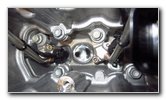 Empty Spark Plug Well |
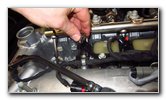 Install New Spark Plug |
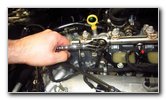 Tighten Clockwise |
| Push the new spark
plug into the socket.
Your spark plug socket should have a rubber insert or a strong magnet to securely hold the new plug in place. Carefully lower the new spark plug down into the well. Spin it in by hand to help prevent it from becoming cross threaded. Continue turning the extension bar in the clockwise direction until you feel it make contact with the cylinder head. Attach the 3/8" drive ratchet and tighten the new spark plug in the clockwise direction until they are snug. If you are installing a new spark plug, you may feel the new crush washer collapse as you are tightening the plug. Continue tightening to a small fraction of a turn past finger tight. If you are re-installing an old spark plug that you were just checking, you only need to tighten it to a small fraction of a turn past finger tight (about 1/16 to 1/8 of a turn). Try to avoid over tightening the spark plugs to prevent from cracking the ceramic part of the plug or stripping the aluminum threads in the cylinder head. If you plan on using a torque wrench to tighten the spark plugs, consult with the spark plug manufacturer for their torque recommendation. The torque recommendation from GM for the earlier Malibu models with the Ecotec 2.4L I4 engine is 11 lb-ft if you applied anti-seize lubricant and 18 lb-ft if the threads are dry with no anti-seize applied. The torque specification in the service manual for the 2011 to 2016 Malibu models with the 2.0L or 2.5L engines is 15 lb-ft (or 20 N.m). If you use a torque wrench, please verify the torque specification for your vehicle before proceeding. Double check that the new spark plug is tight before moving on to the next steps. |
||
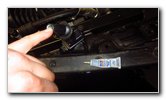 Apply Dielectric Grease |
 Lower In Ignition Coil |
 Spin In Ignition Coil Bolt |
| Apply a small
amount of dielectric grease to the opening in the rubber dust boot at the
bottom of the ignition coil. The dielectric grease well help keep out any moisture or debris and ensure a reliable electrical connection. Lower the ignition coil down into the well and push the rubber dust boot over the top of the new spark plug. Rotate the ignition coil back and forth a few times to help spread the dielectric grease. Line up the bolt hole in the ignition coil with the bolt hole in the valve cover. Spin in the ignition coil bolt a few turns by hand in the clockwise direction to help prevent it from becoming cross threaded. |
||
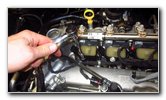 Tighten Bolt Clockwise |
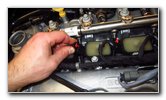 Push On Power Plug |
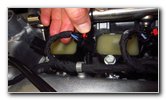 Slide In Red Locking Tab |
| Tighten the bolt in
the clockwise direction with the 10mm socket and a 1/4" drive ratchet until
it is snug. Try to avoid over tightening the bolt to prevent from cracking the plastic ignition coil housing. Slide the electrical connector straight on to the ignition coil. You should feel or hear the electrical connector "click" securely into place. Slide the red lock tab in towards the ignition coil to secure the power plug. |
||
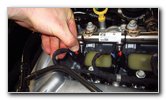 Red Lock Tab Secured |
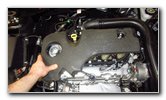 Replace Rubber Cover |
 Lower Plastic Cover |
| Double check that
you have re-attached all of the electrical connectors and secured the red
locking tabs.
Lower the foam rubber noise dampening cover over the top of the engine. Lower the plastic cover down into place. |
||
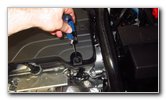 Tighten Torx Screw |
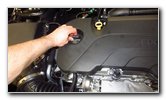 Replace Oil Fill Cap |
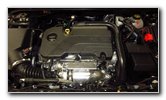 Spark Plugs Replaced |
| Spin in the Torx
screw a few turns by hand in the clockwise direction into the hole in the
front right (driver side) corner of the plastic engine cover. Tighten the screw with the Torx T30 screwdriver in the clockwise direction until it is snug. Remove the small towel from the oil fill hole. Replace the oil fill cap by tightening it in the clockwise direction until it is snug. Start the engine and listen closely for any strange sounds. If you do hear a weird noise, turn off the ignition and double check your work for a disconnected power plug or a loose spark plug. According to the maintenance specifications in the owner's manual, the service interval for the spark plugs in the 1.5L I4 engine and the 2.0L I4 engine is to change them every 60,000 miles (or 96,000 km). (If you have a Malibu equipped with the 1.8L hybrid engine, the spark plugs only need to be changed every 97,500 miles.) Don't forget to write down the spark plug change in your vehicle's service records. Please check out all of the
2016-2023 GM Chevrolet Malibu DIY Repair & Maintenance Guides. |
||
| If you found this guide to be helpful,
please consider making a small donation by clicking on the PayPal.com
"Donate" button located to the right of this paragraph. Thank you!
(Note: I am not a registered charity. Donations are not tax deductible.) |

